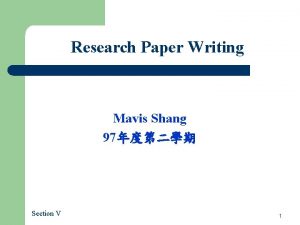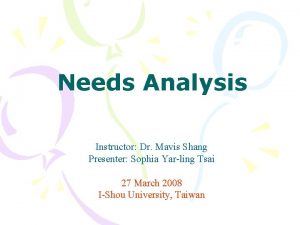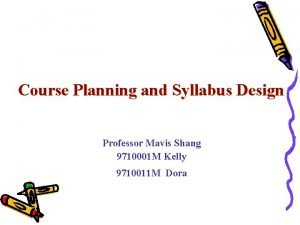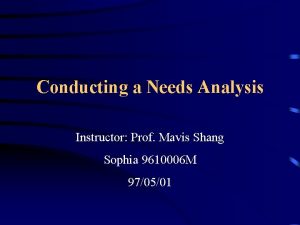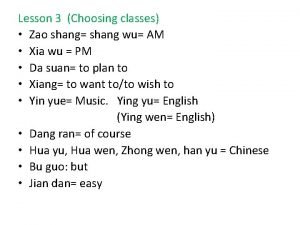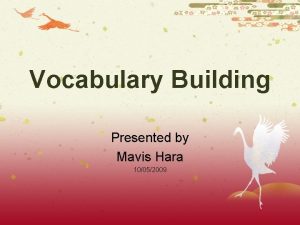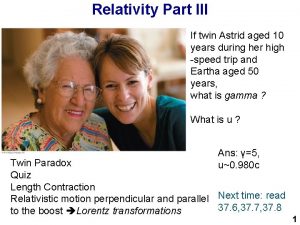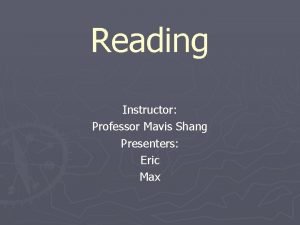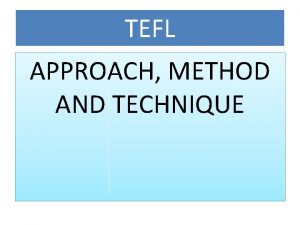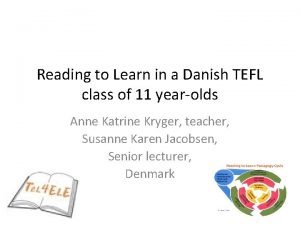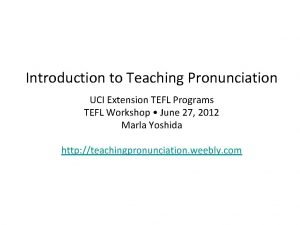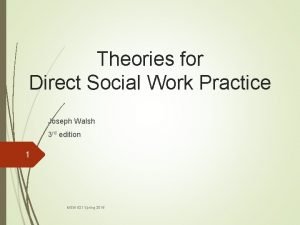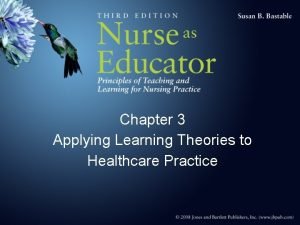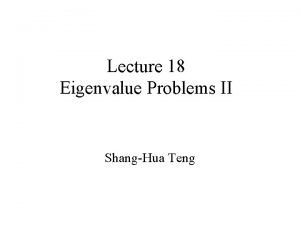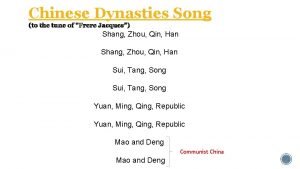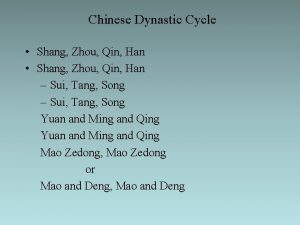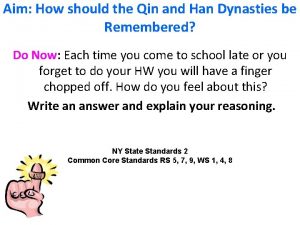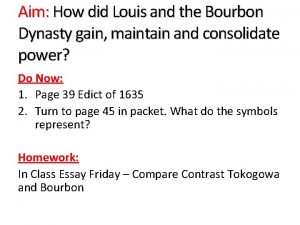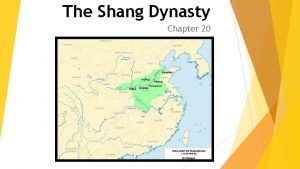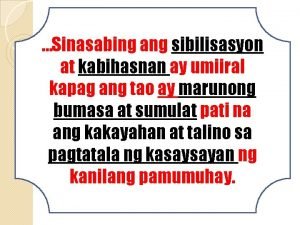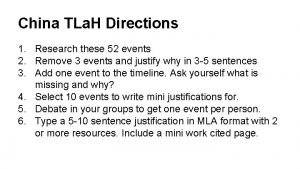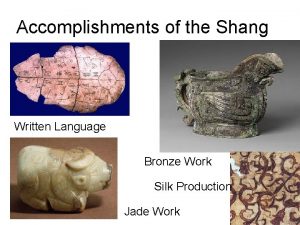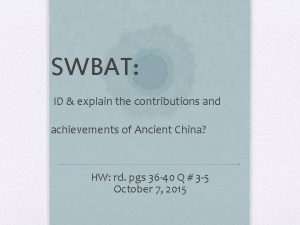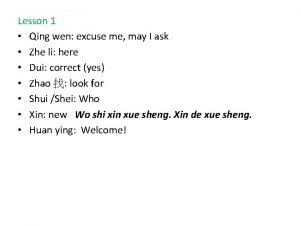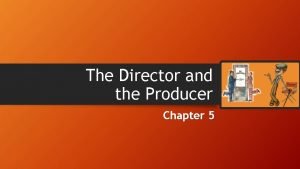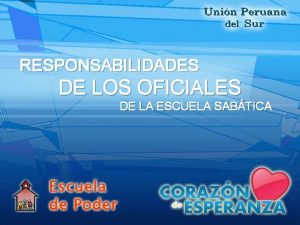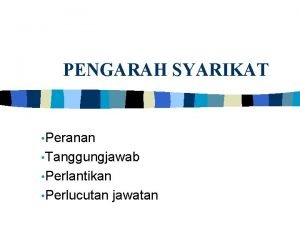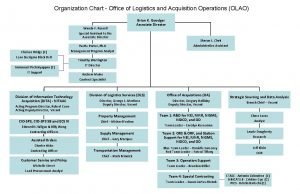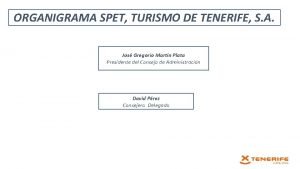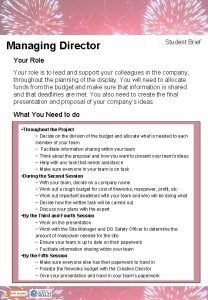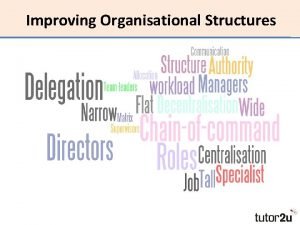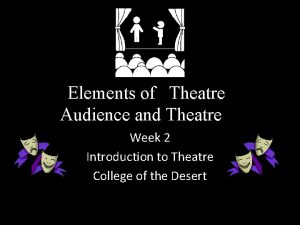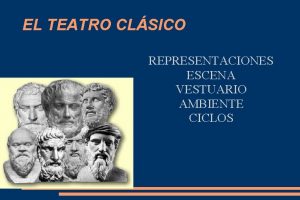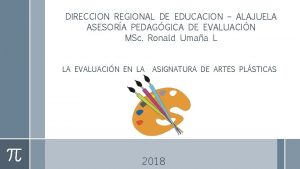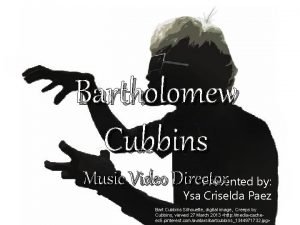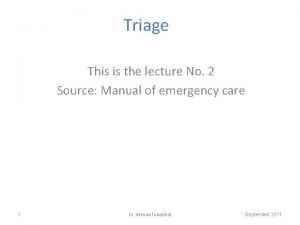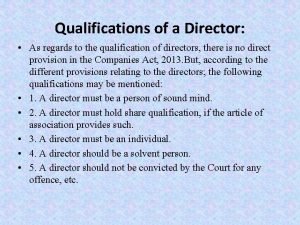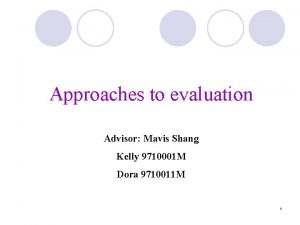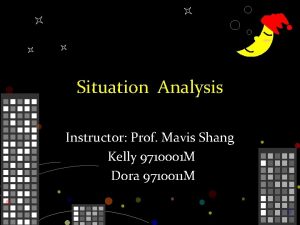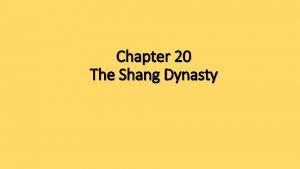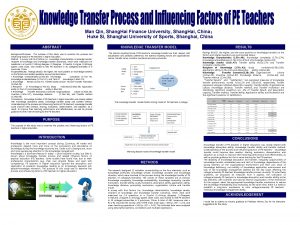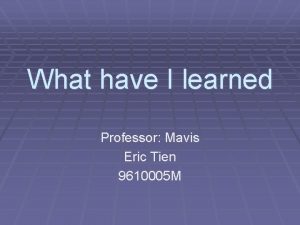THEORIES PRACTICE of TEFL Director Professor Mavis Shang
















































































- Slides: 80

THEORIES & PRACTICE of TEFL Director: Professor Mavis Shang Name & ID: Xavier, Wu 9610008 M Name & ID: Roger, Yu 9610009 M Date: 10/18/2007 Dept. of Applied English of I. S. U.

LISTEN UP!

Aural Comprehension Instruction Introduction n Aspects of listening in L. T. & L. L. n Principles of listening in L. T. & L. L. n Extensive & Intensive Listening n Skills and Strategies n Listening Lesson Sequences n Time of Q AND A n

Introduction – The Importance of Listening A Fundamental Skill Ø A Vehicle for Teaching of Grammatical Structure and Vocabulary Ø The More Opportunities of Using Ø The Best Way for Language Input Ø Establish on Different Stages Ø Extend Learners’ Vocabulary Ø

Aspects of Listening in L. T. & L. L. (1) n Four Models of Listening— Role and Purpose Listening and Repeating #6 Ø Listening and Answering #7 Ø Task Listening #8 Ø Interactive Listening #9 Ø

Model 1: Listening & Repeating GOAL To pattern-match, To listen and imitate, To memorize. Instructional material Audiolingual style, Dialogue memorization, Hearing and pattern mach. Procedure Listen→ Repeat → Memorize Value#5 Pattern drills, repeat dialogues, memorize conversation.

Model 2: Listening & Answering GOAL To process discrete–point information, To listen and answer question. Instructional material Listening-answering model with occasional creative topic. Procedure Listen→ Answer → Memorize Value#5 Increase speed and accuracy of recall, stock of vocabulary and grammar construction

Model 3: Task Listening GOAL To process spoken discourse, To listen and do. Instructional material Listening-and-using for response pattern. Procedure Listen→ Transmission → Do Value#5 To engage learners in using the information content presented in the spoken discourse.

Model 4: Interactive Listening GOAL To develop aural/oral skill, To develop critical listening, thinking, and effective speaking abilities. Instructional material Interactive listening-think-speaking model with two-way. Procedure Discussion→ Speech→ Reaction → Instant response Value#5 Communicative skills in four competency areas— linguistic, discourse, sociolinguistic, strategic competences.

Aspects of Listening in L. T. & L. L. (2) n Three Modes of Communicative Listening—Active Receptive Skill Bidirectional Listening Mode. #11 Ø Unidirectional Listening Mode. #12 Ø Autodirectional Listening Mode. #13 Ø Implication for Instruction. Ø In both of the Two-way mode & One-way mode. ü Self-dialogue should be used connection both of them. #27 ü

n Bidirectional Listening Mode Two-way communicative listening Ø Learners take turns exchanging Speaker Role and Listener Role in face-to-face or telephone interaction. #10

n Unidirectional Listening Mode One-way communicative listening Input comes from the sources of overheard conversation, public performances, telephone answering, the media. Ø Hearing but are unable to interact → Analyze what we hear→ Talk to ourselves in a reaction#10 Ø

n Autodirectional Listening Mode Self-dialogue communicative listening Internal roles: Speaker and Listener/ Reactor in our own thought processes. Ø Re-create language internally →Listening again → Retell and Relive communication. #10 Ø

Aspects of Listening in L. T. & L. L (3) n Psychosocial Function of Listening Transactional Language Function. #15 Ø Interactional Language Function. #16 Ø Implication for Instruction. #27 Ø Providing exercises in both TLF Talk AND ILF Talk. ü Two functions may be Intertwined. ü Instructions→ Listening→ Recognize→ Respond ü

n Transactional Language Function Message Oriented—Clarity & Precision Ø n For Instructions, Directions, Explaining, Describing, Inquiring, Requiring, Checking on correctness of detail. Business-type Talk Ø Focus on content and conveying factual or propositional information. #14

Interactional Language Function n Person Oriented—Identify & Respect Ø n For identifying with other person’s concerns, maintaining and respecting “Face”. Social-type Talk Ø Focus on casual conversation. #14

n Aspects of Listening in L. T. & L. L (4) Psychosocial Processes of Listening Bottom-Up Processes. #18 Ø Top-Down Processes. #19 Ø Implication for Instruction. #20 Ø Interactional: to interact with teacher and student. ü Transactional: to assimilate new input of information, concepts, and skills. ü Purpose, Background knowledge, and Topic. #27 ü

Bottom-Up Processes n Aural Comprehension Process— Attention to Every Detail Input Ø n Understanding of the “heard” process Sound→ Words→ Grammatical Structure→ Lexical meaning. Bottom to Top Ø Base on incoming language data. #17

Top-Down Processes n Aural Comprehension Process— Prior information about task of understanding Internal sources: Prior knowledge and global expectation about language. Ø n Top to Down Ø Prediction and Inference→ Bypass Bottom-to-Top processing. #17

Richard’s Function & Processes Interactional Bottom-Up 1 2 #21 Top-Down #22 3 4 Transactional #17

Ex: Bottom-Up Mode n Cell 1: Listening closely to a joke (Interactional) in order to know when to laugh. #20 Ø Cell 3: Ø Ø Listening closely to instruction (transactional) during a first lesson. #20

Ex: Top-Down Mode n Cell 2: Ø n Listening casually to cocktail party talk (Interactional). #20 Cell 4: Ø Experienced air traveler listening casually to verbal air safety instructions (Transactional) which have new concepts, and acquire new skills. #20

Aspects of Listening in L. T. & L. L (5) n Affective Domain—Attitudinal Information & Emotional Information Ø Linguistic Cue for Affect ü Ø Linguistic Messages#24 Nonlinguistic Cue for Affect Paralinguistic Message#25 ü Extralinguistic Messages#25 ü Intellectual, Emotional, and Moral Attitudes#26 ü

n Linguistic Cue for Affect Linguistic Messages Choosing words Ø Arranging words into sentences Ø Being dialogue discourse Ø Ex: ü That was an (interesting/excellent /good/fair/soso/terrible) movie. ü I like him a lot but… ü Even though she’s my best friend, I must tell you that…#23

Nonlinguistic Cue for Affect Paralinguistic Messages n Voice is used in speaking transmits meaning by different ways. Ø Vocal elements: tone, rate, rhythm, stress. #9 Ø n Extralinguistic Messages Body language transmitted words and vocal information. Ø Elements: postures, movements, gestures, Ø facial expressions, eye contact, talking space. #23

Nonlinguistic Cue for Affect Intellectual Attitudes n Ø Expression & Comprehension: agreement/disagreement; confirming/denying; accepting/ declining; forgetting/ remembering; possibility/ impossibility; capability/ incapability; uncertainly; obligation; permission. Emotional Attitudes n Moral Attitudes n #23

Aspects of Listening in L. T. & L. L (6) n Listening as a Language Act Information Processing #10 Ø Linguistic Functions #14 Ø Dimensions of Cognitive processing #17 Ø

Principles of Listening Teaching(1) Three Materials Development n Principles. Relevance—content and outcome#29 Ø Transferability/Applicability—can be used in other courses. #30 Ø Task orientation—combine language use tasks and language analysis activities. #31 Ø

Relevance n Content Ø n Outcome Ø n The information input. Natural use of the information. Face Validity for Students Ø Encouraging the intention to learn. #11

Transferability/Applic ability n Content Level or Outcome Level Ø n Can be used in other courses Foster Transfer of Training Ø The mirror of real life by activities. Radio ü Television new ü Broadcast#11 ü

Task Orientation(1) n Language Use Tasks Ø Listen-and-Do communicative outcomes Listening and performing actions ü Listening and performing operation ü Listening and solving problems ü Listening and transcribing ü Listening and summarizing information ü Interactive listening and Q/A routines ü

Task Orientation(2) n Language Use Tasks Ø A base on Content Experiences Increase vocabulary ü Increase predictive ability including Schemata and Scripts. ü Ø A base on Operational Experiences ü Acquire ability of familiar information -handling operations.

Task Orientation(3) n Language Analysis Activities Ø The opportunities to analyze selected aspects. Language Structure—Form ü Language Use—Function ü Ø To develop personal strategies. ü Knowledgeable

Task Orientation(4) n Specific Language Analysis Activities Analysis of task of fast speed. Ø Analysis of phrasing and pause point. Ø Analysis monologues and dialogue exchange. Ø Describing and analysis sociolinguistic dimensions. Ø Describing and analysis communicative strategies. #28 Ø

TIME for Q and A THANK YOU FOR ATTENTION See you next week

Principles of Listening Teaching(2) Communicative Outcomes—An n Organizing Framework Listening and Performing Actions and Operations. #37 Ø Listening and Transferring Information. #38 Ø Listening and Solving Problems. #39 Ø

n Communicative Outcome(1) Listening and Performing Actions and Operations—Responses to Directions/Instructions/Descriptions Drawing something. Ø A map task. Ø Selecting work. Ø Performing a movement. Ø Operating a piece of equipment. Ø Carrying out steps in a process. #36 Ø

Communicative Outcome(2) Spoken-to-Written Listening and Transferring Information— n ü Taking a message and transferring to another person. Listening and filling in blanks. Listening and completing a form or chart. Listening and Carrying out steps in a process. Listening to a how to talk and writing. Listening to a speech and taking a note. n Spoken-to-Spoken ü ü ü ü Listening to directions and passing them. Listening to part of story and repeating it to others. #36

n Communicative Outcome(3) Listening and Solving Problems— Games and Puzzles Words games. Ø Number games and story. Ø Asking questions. Ø careful listening to the completion of the game. Ø listening story and settle solutions. Ø A jigsaw mystery. Ø Comparison shopping task. Ø Short descriptions of court case. #36 Ø

Principles of Listening Teaching(3) Communicative Outcomes— n An Organizing Framework Listening, Evaluating, and Manipulating Information. #41 Ø Interactive listening-and-Speaking. #42 Ø Listening for Enjoyment, Pleasure, and Sociability. #43 Ø

n Communicative Outcome(4) Listening, Evaluating, and Manipulating Information— Evaluate and Manipulate Receiving information and answer questions. Ø Evaluating information. Ø Evaluating arguments. Ø Evaluating cause-and effect information. Ø Summarizing or gist of information. Ø Evaluate and combining or considering information. Ø Evaluating and extending information. Ø Organizing unordered information. #40 Ø

n Communicative Outcome(5) Interactive listening-and-Speaking— produce and process Repetition—Question Asking Ø Paraphrase—Different Restatement Ø Verification—Confirmation Ø Clarification—Explanation Ø Elaboration—Additional Information Ø Extension—For New Point Ø Challenge—Conclusion#40 Ø

n Communicative Outcome(6) Listening for Enjoyment, Pleasure, and Sociability— Teacher-talk and Student-talk Songs Ø Stories Ø Plays Ø Poems Ø Jokes Ø Anecdotes Ø Interesting chat#40 Ø

Extensive & Intensive Listening Comparison of the Locations n Comparison of the Materials n Comparison of the Advantages n Comparison of the Disadvantages n #45 #46 #47 #48 n Comparison of Roles of the Teachers

Location Extensive Listening Outside Classroom Home üCar üPersonal stereo üIn the Travel ü #44 Intensive Listening In the Classroom Teacher üClassmates üMaterials ü

Material Extensive Listening Tape ü Intensive Listening Tape Listening #47 ü Learners’ Level Get-Information Task Ø Reading & Listening üAuthentic Material Ø ü Native Speaker Ø Task for Output ü #44 Live Listening ü Class talk ØReading aloud ØStory-telling ØInterviews Ø

Procedure of Using Tape Material n n n Prediction and Gist Task—First Listening Listen the Tape Give a Task—Get Information and Listen. Return the Tape—Detail Comprehension, and Language Analysis. Play again—If Students Want to do. #46

Advantages Extensive Listening #44 Intensive Listening More listening Opportunities l. Tape üMore Language Acquire üTo listening different üListening Activities in General character üExtremely portable üSchematic Knowledge üImproving Vocabulary l. Live Listening üImproving Grammar üInteraction between Speaker and Listener üTo Be Better Reader üCan see who are listen to. üCan adjust speed for listener. ü

Disadvantages Extensive Listening Low motivation due to wrong level üLanguage may unnatural üHard to evaluate üCan not help students ü #44 Intensive Listening Tape l For Big Class hard to ensure all student can hear equally well üDo not have Interaction l. Live Listening üSpend more time for Preparation ü

Roles of Teachers Extensive Listening Introducer What is Purpose üDirector What is go to do… üSupervisor How to do the task… ü #44 Intensive Listening Organiser ü Purpose and Instructions Machine Operator Be a good Player üFeedback Organiser Feedback Session to check the task. üPrompter ü

Process & Skill & Strategy Higher Level Process. n Lower Level Process. n The Comprehension Process. n #19 #20 Information view Ø Construct Meaning Ø

n Process & Skill & Strategy Types of Strategies. Metacognitive Strategy Ø Cognitive Strategy Ø Socioaffective Strategy Ø Top-down Strategy Ø

n Process & Skill & Strategy Different Stages of Skills. Novice Stage Ø Intermediate stage Ø Advanced Stage Ø n Different Goals of Skill. Techniques for Global Listening Ø Selective Listening Ø Goals and Exercises Ø

Process & Skill & Strategy Goals of Novice Stage n Exercises of Novice Stage n Goals of Intermediate Stage n Exercises of Intermediate Stage n Goals of Advanced Stage n Exercises of Advanced Stage n

Goals of Novice Stage Bottom-Up Processing Discriminate Intonation in Sentences n Discriminate Phonemes n Listen for Morphological Ending n Recognize Syllable Patterns, Number of Syllables, and Word Stress n Be Aware of Sentence Fillers in Informal Speech n Select Details form the Text n

Goals of Novice Stage Top-Down Processing Discriminate Emotional Reactions n Get the Gist or Main Idea n Recognize the Topic n

Goals of Novice Stage Interactive Processing Formal or Informal by Speech Features n Recognize a Familiar word and Relative Category n Compare Information in Memory with information n Compare information with experience n

Goals of Intermediate Stage Bottom-Up Processing Differences Content and Function Words by Stress Pattern n Find the Stressed Syllable n Recognize Words with Reduced Vowels or Dropped Syllables n Recognize Words as they are Linked in the Speech Steam n Recognize Pertinent Details in the Speech Stream n

Goals of Intermediate Stage Top-Down Processing Discriminate Register of Speech and Tones of Voice n Listen to Identify the Speaker or the Topic n Find Main Ideas and Supporting Details n Make Inferences n

Goals of Intermediate Stage Interactive Processing Use Word Stress to Understand the Speaker’s Intent n Recognize Missing Grammar Markers in Colloquial Speech and Reconstruct the Message n Use Context and Knowledge of the World to Build Listening Expectations; Listen to Confirm Expectations n

Goals of Advanced Stage Bottom-Up Processing Use Sentence Stress and Intonation to Identify Important Information n Recognize Contractions, Reduced Forms, Differ From the Written Form n Become Aware of Common Performance Slips that Must be Reinterpreted or Ignored n

Goals of Advanced Stage Bottom-Up Processing Become Aware of Organizational Cue in Lecture Text n Become Aware of Lexical and Suprasegmental Markers for Definitions n Identify Specific Points of Information n

Goals of Advanced Stage Top-Down Processing Use Knowledge to Predict the Content n Use the Introduction to Predict its Focus and Direction n Use the Transcript to Predict the Content of the next Section n Find the Main Idea of Segment n Recognize Concepts n

Goals of Advanced Stage Interactive Processing Use Knowledge of Phrases and Discourse Markers to Predict the Content in the next Segment of the Lecture n Make Inferences about the Text n

n Listening Lesson Sequences Interview #52 Re-order n Telephone Message n Completing the Task n Sharing and Solving the problem n Daily Spoken Drill n The Sound of Music n #53 #55 #56 #62 #64 #58

n n n n Give Interview’s Question before Predict the Interview Bring a Strangers into classroom (Native Speaker) Brief the students’ Level Guess and Write down Questions Ask Question and Make Notes Prompt students to ask Follow-up Question Write a Short Essay about person #51

Listening and put picture in the Order. n To say what may Happening in the picture. n Do not Confirm and Deny their Prediction. n Listen and Re-order for Correctness. n

Listen again and check the orders of correctness. n Teacher should lead student listen again about some interest point. #51 n

n n n Teachers make three Simple records of Phone Calls. Asking students Take Short Messages. Compare each other to see they have written same thing. Listening again and Clear up any Problem. Also can taking message from speaking or other materials. #51

Listen to Different Tapes. n Share Different Information. n Gather and Share Detail information to Complete the Task. n

n n Divide into Group A and Group B listening Different Tape Interview each other Making Notes and Discuss information Complete the Form of Task. #51

n n n Leading a Discussion about Topic. Help students Come up with Sentence Pattern. Share Personal Experience. Listen to Material and Look at Picture for prediction. #58 Discussion and Think for Solving Problem. #58

Three Horror Story on Holiday #57

n n n Listen ti the Extracts again for the speaker construct their discourse. Check Language with teacher before moving on to use the results of their enquire in a making conversations activities. Encourage them to try to Try Out the Language. #60

n Listening Extracts can be used for different purpose—Language Skills, Language Analysis, Language Production. #51

n n Be studied for information about How the text is Constructed. What Orders certain Functions can occur within an exchange. Both Simplified and Authentic text. About Normal Lives of Everyday Spoken reality.

n Looking Transcript and notice real language is. 1) a request for service ( line 1) 2) an acknowledgement of the request and a statement of the price (line 2 -3) 3) the handing over of the goods (line 4) 4) the giving of money and receiving the change (line 5 -6)

n n Students’ song or Teacher’s song Pre-discussion → Worksheet#64 → Instructions → Compare and Check answers → Listen again → Read the answer with song → Asking question about song → Explanation → Listen again


TIME for Q and A THANK YOU FOR ATTENTION
 Mavis shang
Mavis shang Mavis shang
Mavis shang Mavis shang
Mavis shang Mavis shang
Mavis shang Content based syllabus example
Content based syllabus example Mavis shang
Mavis shang Zao shang vs shang wu
Zao shang vs shang wu Mavis chung
Mavis chung Mavis hara
Mavis hara Volo nolo
Volo nolo Mavis 500s
Mavis 500s Eric mavis
Eric mavis Promotion from assistant to associate professor
Promotion from assistant to associate professor Examples of approach, method and technique
Examples of approach, method and technique Tefl in denmark
Tefl in denmark Introduction to teaching pronunciation
Introduction to teaching pronunciation Theories and values of positive practice
Theories and values of positive practice Humanistic theories examples
Humanistic theories examples Theories for direct social work practice
Theories for direct social work practice Learning theories related to health care practice
Learning theories related to health care practice Shang dynasty map yellow river
Shang dynasty map yellow river Water clocks han dynasty
Water clocks han dynasty Shang dynasty jobs
Shang dynasty jobs Shang-hua teng
Shang-hua teng Shang zhou qin han
Shang zhou qin han Shang zhou qin han
Shang zhou qin han Ming dynasty ap world history
Ming dynasty ap world history Shang dynasty acrostic poem
Shang dynasty acrostic poem Shang dynasty timeline
Shang dynasty timeline How did louis xiv gain consolidate and maintain power
How did louis xiv gain consolidate and maintain power What were two accomplishments of the shang dynasty
What were two accomplishments of the shang dynasty Menurut shang yang
Menurut shang yang Tujuan negara menurut shang yang
Tujuan negara menurut shang yang Shang dynasty accomplishments
Shang dynasty accomplishments Shang dynasty
Shang dynasty Pag-uuri sa lipunan ng kabihasnang shang
Pag-uuri sa lipunan ng kabihasnang shang Shang dynasty language
Shang dynasty language Name three important values of shang culture
Name three important values of shang culture Shang abi 是誰
Shang abi 是誰 Shang ring sizes
Shang ring sizes Shang dynasty map
Shang dynasty map Shang china
Shang china Wo men de tian fu
Wo men de tian fu Where was the shang dynasty located
Where was the shang dynasty located Landforms in china
Landforms in china Houmuwu ding
Houmuwu ding Shang accomplishments
Shang accomplishments Contributions of the shang dynasty
Contributions of the shang dynasty Zao shang hao
Zao shang hao Shang ring
Shang ring Shang-ping xie
Shang-ping xie Legalism ancient china
Legalism ancient china Shang dynasty public works
Shang dynasty public works What was the role of shang warlords
What was the role of shang warlords Myeplg
Myeplg The text-based director, also known as the
The text-based director, also known as the Responsabilidades de un director de escuela
Responsabilidades de un director de escuela I scurt
I scurt Tugas director syarikat
Tugas director syarikat Logistic organization chart
Logistic organization chart Procolombia organigrama
Procolombia organigrama Oliver stone
Oliver stone Salaam bombay! nominations
Salaam bombay! nominations Role brief
Role brief Types of span of control in organization
Types of span of control in organization Director ict
Director ict Health and freedom usana
Health and freedom usana Director hand signals
Director hand signals Codirector o co-director
Codirector o co-director Importance of audience in theatre
Importance of audience in theatre Electron donating groups examples
Electron donating groups examples Vestuario del teatro romano
Vestuario del teatro romano Ficha tecnica de la pelicula el pianista
Ficha tecnica de la pelicula el pianista Director regional de alajuela
Director regional de alajuela Director of technical education hp
Director of technical education hp Director message in company profile
Director message in company profile Director class
Director class Managing change images
Managing change images Bart cubbins
Bart cubbins Pt demographics
Pt demographics Qualification of a director
Qualification of a director

